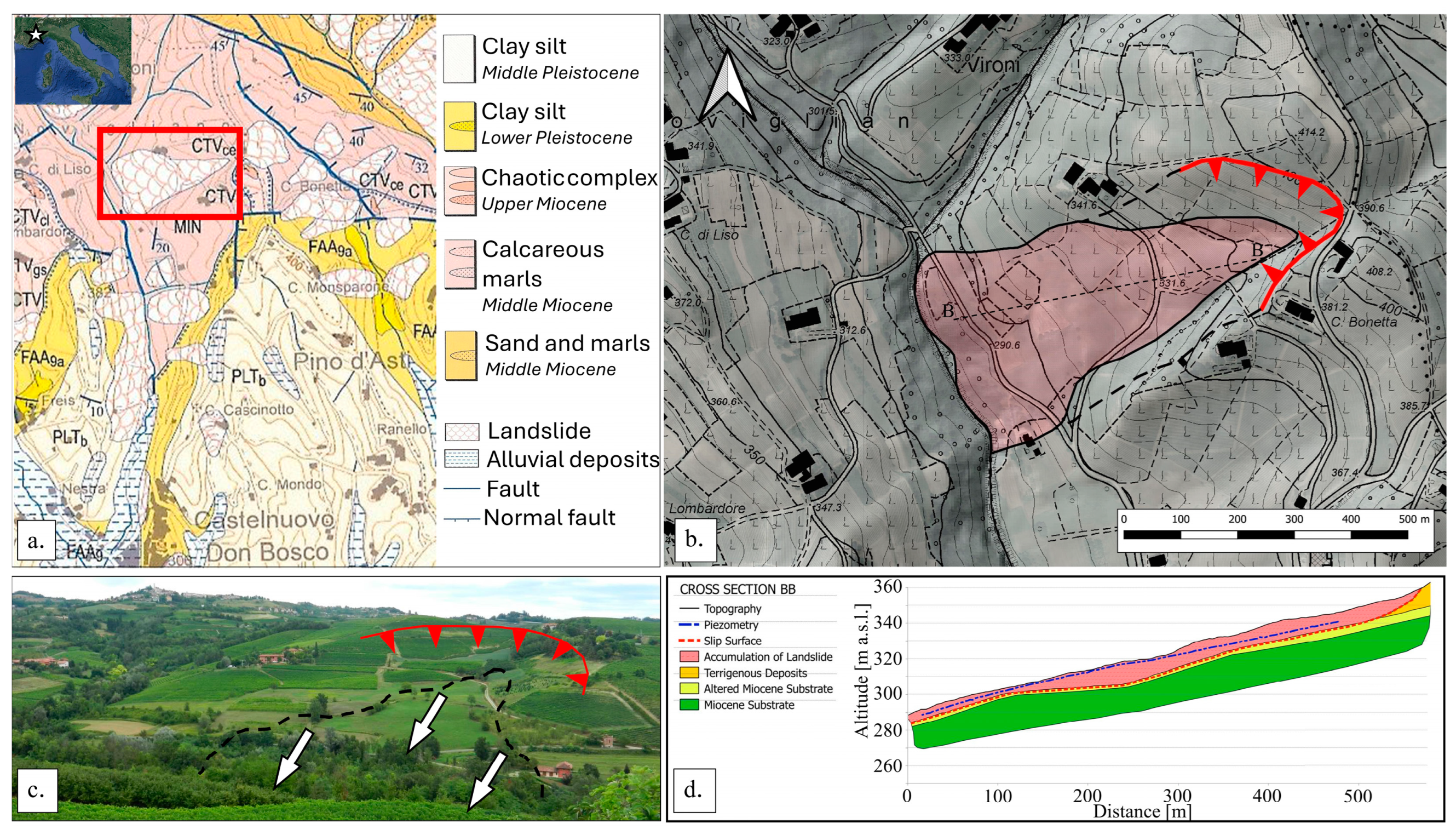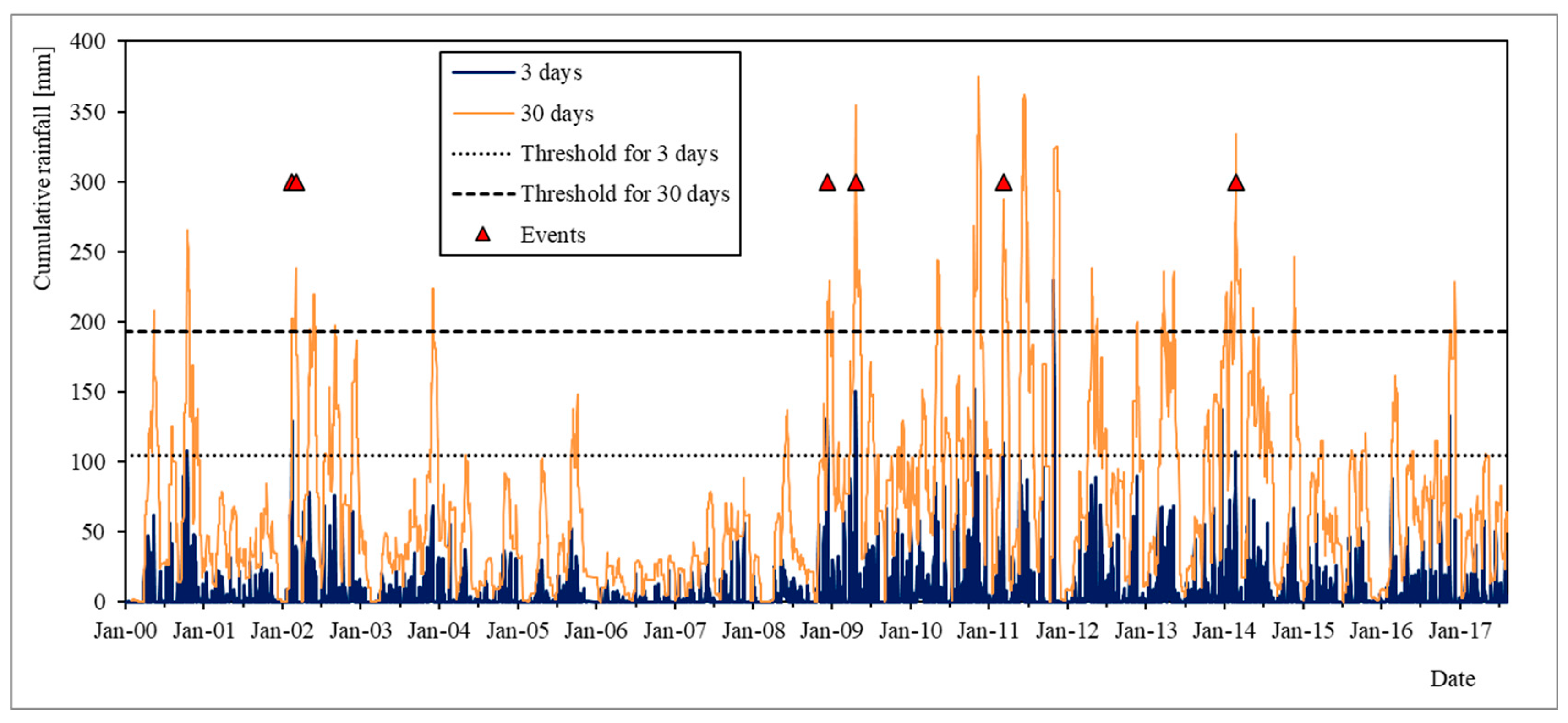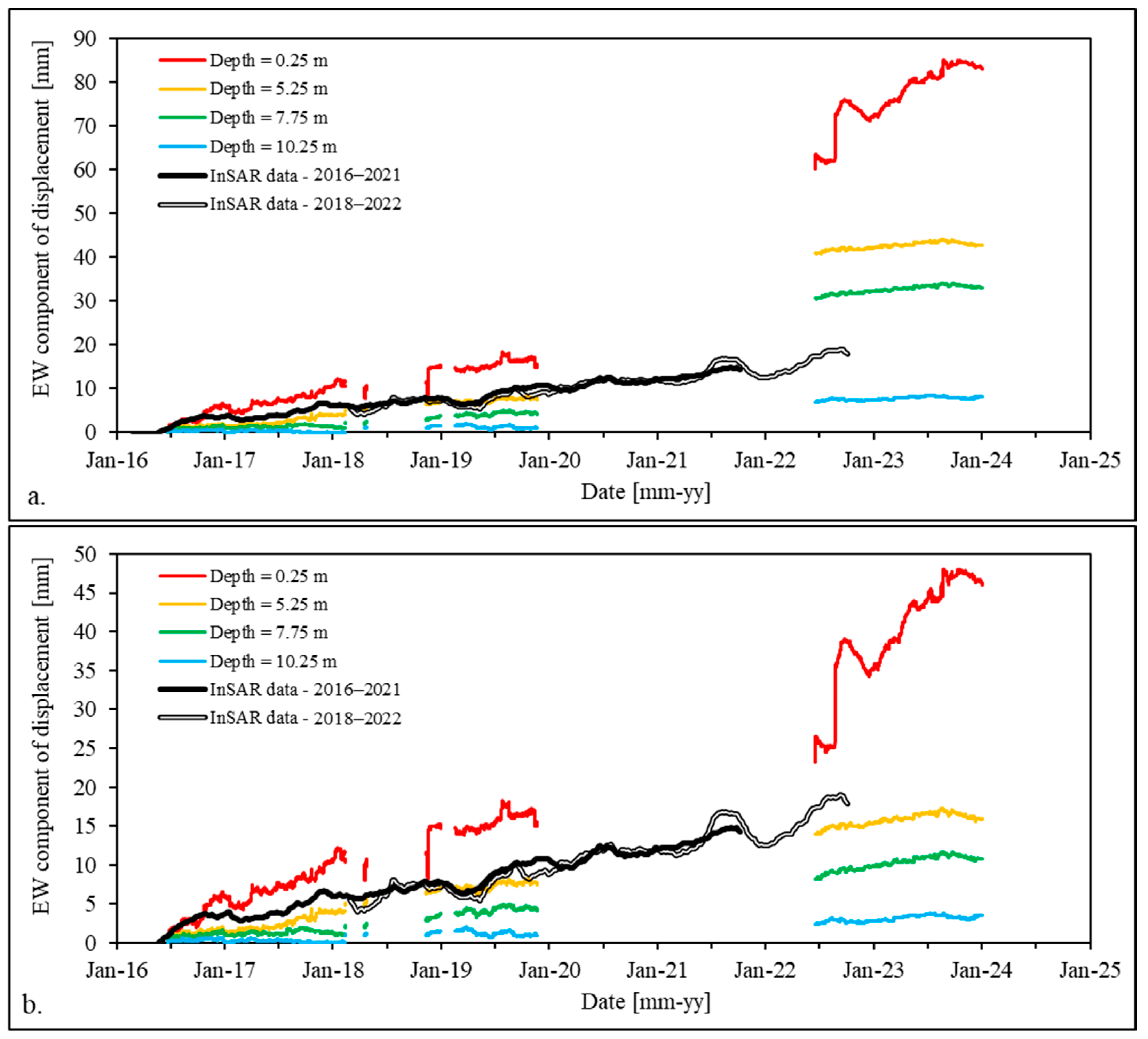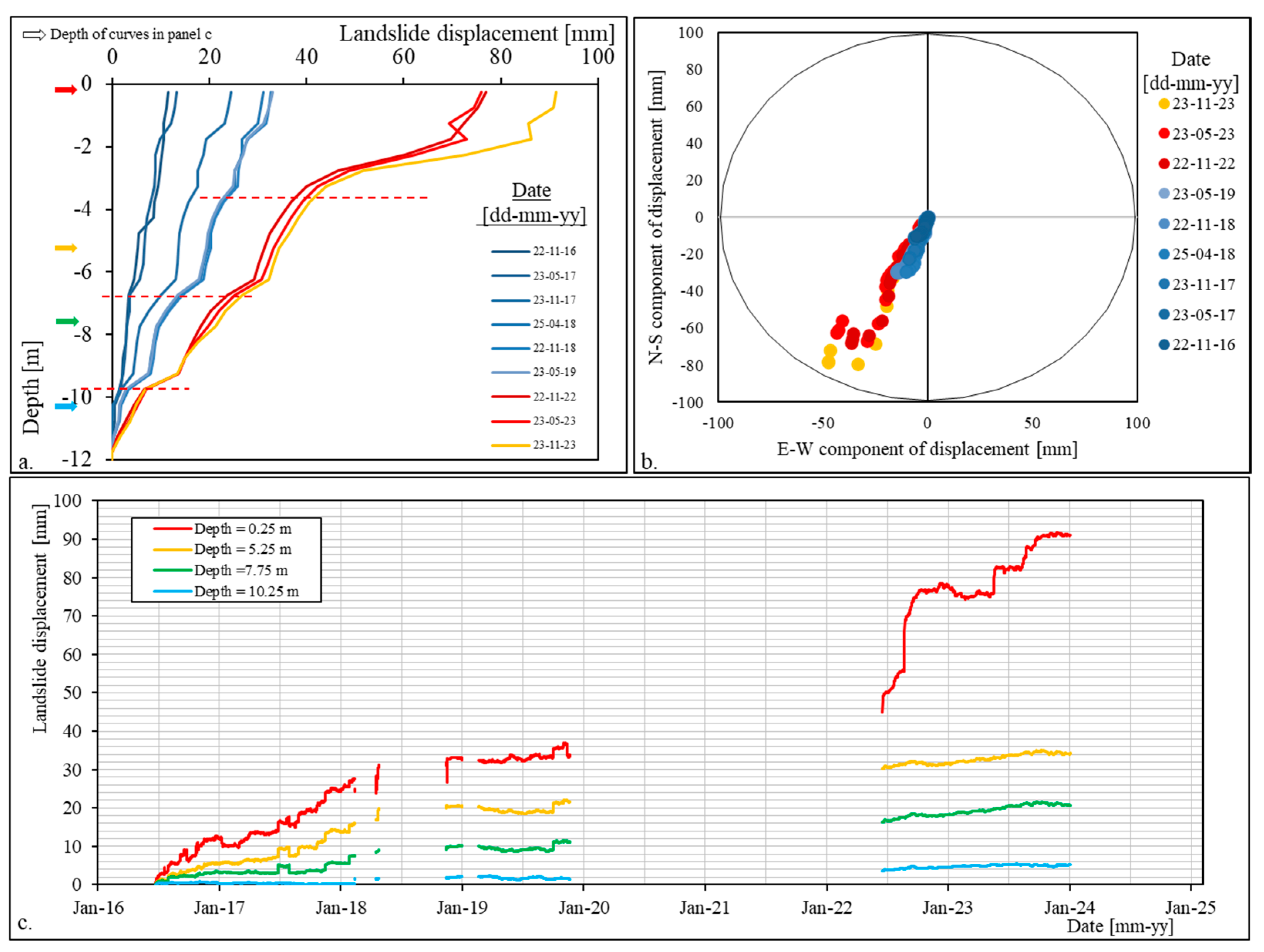Instrumental Monitoring of a Slow-Moving Landslide in Piedmont (Northwest Italy) for the Definition of Rainfall Thresholds
Abstract
:1. Introduction
2. Geological Setting
2.1. Regional Geology
2.2. Local Geology and Geomorphology

2.3. The Nevissano Landslide
3. Materials and Methods
3.1. Definition of Rain Thresholds
3.2. Monitoring of the Landslide
3.2.1. Monitoring System
3.2.2. Data Elaboration
3.2.3. Calibration after Shutdown
3.3. Validation of Rain Thresholds
4. Results
4.1. Definition of Rain Thresholds
4.2. Monitoring of the Landslide
- -
- Between 3 and 4 m of depth;
- -
- Between 6 and 7 m of depth;
- -
- Between 9 and 10 m of depth.
4.3. Validation of Rain Thresholds
5. Discussion and Conclusions
Author Contributions
Funding
Institutional Review Board Statement
Informed Consent Statement
Data Availability Statement
Acknowledgments
Conflicts of Interest
References
- Bozzano, F.; Lenti, L.; Martino, S.; Paciello, A.; Scarascia Mugnozza, G. Self-Excitation Process Due to Local Seismic Amplification Responsible for the Reactivation of the Salcito Landslide (Italy) on 31 October 2002. J. Geophys. Res. Solid Earth 2008, 113, B10312. [Google Scholar] [CrossRef]
- Iverson, R.M. Landslide Triggering by Rain Infiltration. Water Resour. Res. 2000, 36, 1897–1910. [Google Scholar] [CrossRef]
- Khalili, M.A.; Guerriero, L.; Pouralizadeh, M.; Calcaterra, D.; Di Martire, D. Monitoring and Prediction of Landslide-Related Deformation Based on the GCN-LSTM Algorithm and SAR Imagery. Nat. Hazards 2023, 119, 39–68. [Google Scholar] [CrossRef]
- Keefer, D.K. Investigating Landslides Caused by Earthquakes—A Historical Review. Surv. Geophys. 2002, 23, 473–510. [Google Scholar] [CrossRef]
- Mantovani, J.R.; Bueno, G.T.; Alcântara, E.; Park, E.; Cunha, A.P.; Londe, L.; Massi, K.; Marengo, J.A. Novel Landslide Susceptibility Mapping Based on Multi-Criteria Decision-Making in Ouro Preto, Brazil. J. Geovis. Spat. Anal. 2023, 7, 7. [Google Scholar] [CrossRef]
- Qin, H.; Wang, J.; Mao, X.; Zhao, Z.; Gao, X.; Lu, W. An Improved Faster R-CNN Method for Landslide Detection in Remote Sensing Images. J. Geovis. Spat. Anal. 2023, 8, 2. [Google Scholar] [CrossRef]
- Calcaterra, D.; Parise, M.; Palma, B.; Pelella, L. The Influence of Meteoric Events in Triggering Shallow Landslides in Pyroclastic Deposits of Campania, Italy. In Proceedings of the Landslides in Research, Theory and Practice: Proceedings of the 8th International Symposium on Landslides, Cardiff, Wales, 26–30 June 2000; Thomas Telford Publishing: London, UK, 2000; pp. 1, 209–214, ISBN 978-0-7277-3648-2. [Google Scholar]
- Aleotti, P. A Warning System for Rainfall-Induced Shallow Failures. Eng. Geol. 2004, 73, 247–265. [Google Scholar] [CrossRef]
- Guzzetti, F.; Carrara, A.; Cardinali, M.; Reichenbach, P. Landslide Hazard Evaluation: A Review of Current Techniques and Their Application in a Multi-Scale Study, Central Italy. Geomorphology 1999, 31, 181–216. [Google Scholar] [CrossRef]
- Guzzetti, F. Landslide Fatalities and the Evaluation of Landslide Risk in Italy. Eng. Geol. 2000, 58, 89–107. [Google Scholar] [CrossRef]
- Baum, R.L.; Godt, J.W. Early Warning of Rainfall-Induced Shallow Landslides and Debris Flows in the USA. Landslides 2010, 7, 259–272. [Google Scholar] [CrossRef]
- Guzzetti, F.; Cardinali, M.; Reichenbach, P.; Cipolla, F.; Sebastiani, C.; Galli, M.; Salvati, P. Landslides Triggered by the 23 November 2000 Rainfall Event in the Imperia Province, Western Liguria, Italy. Eng. Geol. 2004, 73, 229–245. [Google Scholar] [CrossRef]
- Campbell, R.H. Soil Slips, Debris Flows, and Rainstorms in the Santa Monica Mountains and Vicinity, Southern California; US Government Printing Office: Chicago, IL, USA, 1975. [CrossRef]
- Starkel, L. The Role of Extreme Meteorological Events in the Shaping of Mountain Relief. Geogr. Pol. 1979, 41, 13–203. [Google Scholar]
- Crozier, M.J. Landslides: Causes, Consequences and Environment; Croom Helm Australia Pty. Ltd.: London, UK, 1986; p. 252. [Google Scholar]
- Fubelli, G.; Tononi, M.; Valeri, F. Evaluation of the rainfall threshold for shallow and middle-deep landslide triggering: The case of middle-Aniene basin. Rend. Online Soc. Geol. Ital. 2012, 21(Part 1), 572–573. [Google Scholar]
- Fubelli, G. Rainfall Thresholds for Mid-Depth Landslide Triggering: Assessment Method Applied to a Translational Rock Slide in Central Italy. In Proceedings of the Geophysical Research Abstracts, Vienna, Austria, 27 April–2 May 2014; Volume 16, p. 5604. [Google Scholar]
- Michoud, C.; Bazin, S.; Blikra, L.H.; Derron, M.-H.; Jaboyedoff, M. Experiences from Site-Specific Landslide Early Warning Systems. Nat. Hazards Earth Syst. Sci. 2013, 13, 2659–2673. [Google Scholar] [CrossRef]
- Segalini, A.; Carini, C. Underground Landslide Displacement Monitoring: A New MMES Based Device. In Landslide Science and Practice: Volume 2: Early Warning, Instrumentation and Monitoring; Margottini, C., Canuti, P., Sassa, K., Eds.; Springer: Berlin/Heidelberg, Germany, 2013; pp. 87–93. ISBN 978-3-642-31445-2. [Google Scholar]
- Segalini, A.; Valletta, A.; Carri, A. Landslide Time-of-Failure Forecast and Alert Threshold Assessment: A Generalized Criterion. Eng. Geol. 2018, 245, 72–80. [Google Scholar] [CrossRef]
- Huggel, C.; Khabarov, N.; Obersteiner, M.; Ramírez, J. Implementation and Integrated Numerical Modeling of a Landslide Early Warning System: A Pilot Study in Colombia. Nat. Hazards 2009, 52, 501–518. [Google Scholar] [CrossRef]
- Stähli, M.; Sättele, M.; Huggel, C.; McArdell, B.W.; Lehmann, P.; Van Herwijnen, A.; Berne, A.; Schleiss, M.; Ferrari, A.; Kos, A.; et al. Monitoring and Prediction in Early Warning Systems for Rapid Mass Movements. Nat. Hazards Earth Syst. Sci. 2015, 15, 905–917. [Google Scholar] [CrossRef]
- Yin, Y.; Wang, H.; Gao, Y.; Li, X. Real-Time Monitoring and Early Warning of Landslides at Relocated Wushan Town, the Three Gorges Reservoir, China. Landslides 2010, 7, 339–349. [Google Scholar] [CrossRef]
- Sättele, M.; Krautblatter, M.; Bründl, M.; Straub, D. Forecasting Rock Slope Failure: How Reliable and Effective Are Warning Systems? Landslides 2016, 13, 737–750. [Google Scholar] [CrossRef]
- Tomás, R.; Zeng, Q.; Lopez-Sanchez, J.M.; Zhao, C.; Li, Z.; Liu, X.; Navarro-Hernández, M.I.; Hu, L.; Luo, J.; Díaz, E.; et al. Advances on the Investigation of Landslides by Space-Borne Synthetic Aperture Radar Interferometry. Geo-Spat. Inf. Sci. 2023, 1–22. [Google Scholar] [CrossRef]
- He, K.; Luo, G.; Xi, C.; Liu, B.; Hu, X.; Zhou, R. InSAR-Derived Predisaster Spatio-Temporal Evolution of a Reactivated Landslide. Bull. Eng. Geol. Environ. 2024, 83, 170. [Google Scholar] [CrossRef]
- Cook, M.E.; Brook, M.S.; Hamling, I.J.; Cave, M.; Tunnicliffe, J.F.; Holley, R. Investigating Slow-Moving Shallow Soil Landslides Using Sentinel-1 InSAR Data in Gisborne, New Zealand. Landslides 2023, 20, 427–446. [Google Scholar] [CrossRef]
- Xia, Z.; Motagh, M.; Li, T.; Roessner, S. The June 2020 Aniangzhai Landslide in Sichuan Province, Southwest China: Slope Instability Analysis from Radar and Optical Satellite Remote Sensing Data. Landslides 2022, 19, 313–329. [Google Scholar] [CrossRef]
- Confuorto, P.; Casagli, N.; Casu, F.; De Luca, C.; Del Soldato, M.; Festa, D.; Lanari, R.; Manzo, M.; Onorato, G.; Raspini, F. Sentinel-1 P-SBAS Data for the Update of the State of Activity of National Landslide Inventory Maps. Landslides 2023, 20, 1083–1097. [Google Scholar] [CrossRef]
- Mondini, A.C.; Guzzetti, F.; Chang, K.-T.; Monserrat, O.; Martha, T.R.; Manconi, A. Landslide Failures Detection and Mapping Using Synthetic Aperture Radar: Past, Present and Future. Earth-Sci. Rev. 2021, 216, 103574. [Google Scholar] [CrossRef]
- Segalini, A.; Carri, A.; Valletta, A.; Martino, M. Innovative Monitoring Tools and Early Warning Systems for Risk Management: A Case Study. Geosciences 2019, 9, 62. [Google Scholar] [CrossRef]
- Crosetto, M.; Solari, L.; Mróz, M.; Balasis-Levinsen, J.; Casagli, N.; Frei, M.; Oyen, A.; Moldestad, D.A.; Bateson, L.; Guerrieri, L.; et al. The Evolution of Wide-Area DInSAR: From Regional and National Services to the European Ground Motion Service. Remote Sens. 2020, 12, 2043. [Google Scholar] [CrossRef]
- Crosetto, M.; Solari, L.; Balasis-Levinsen, J.; Bateson, L.; Casagli, N.; Frei, M.; Oyen, A.; Moldestad, D.A.; Mróz, M. Deformation Monitoring at European Scale: The Copernicus Ground Motion Service. Int. Arch. Photogramm. Remote Sens. Spat. Inf. Sci. 2021, XLIII-B3-2021, 141–146. [Google Scholar] [CrossRef]
- Costantini, M.; Minati, F.; Trillo, F.; Ferretti, A.; Novali, F.; Passera, E.; Dehls, J.; Larsen, Y.; Marinkovic, P.; Eineder, M.; et al. European Ground Motion Service (EGMS). In Proceedings of the 2021 IEEE International Geoscience and Remote Sensing Symposium IGARSS, Brussels, Belgium, 11–16 July 2021; pp. 3293–3296. [Google Scholar]
- Rossi, M.; Mosca, P.; Polino, R.; Rogledi, S.; Biffi, U. New outcrop and subsurface data in the tertiary piedmont basin (nw-italy): Unconformity-bounded stratigraphic units and their relationships with basin-modification phases. Riv. Ital. Paleontol. Stratigr. 2009, 115, 305–335. [Google Scholar] [CrossRef]
- Bertotti, G.; Mosca, P. Late Orogenic Vertical Movements within the Arc of the SW Alps and Ligurian Alps. Tectonophysics 2009, 475, 117–127. [Google Scholar] [CrossRef]
- Bonsignore, G.; Bortolami, G.; Elter, G.; Montarsio, A.; Petrucci, F.; Ragni, U.; Sacchi, R.; Sturani, C.; Zanella, E. Note Illustrative Dei Fogli 56-57, Torino-Vercelli Della Carta Geologica d’Italia Alla Scala 1:100.000; Serv. Geol. It.: Roma, Italy, 1969. [Google Scholar]
- Festa, A.; DelaPierre, F.; Irace, A.; Piana, F.; Fioraso, G.; Lucchesi, S.; Boano, P.; Forno, M.G. Note Illustrative Della Carta Geologica d’Italia Alla Scala 1: 50.000, Foglio 156 “Torino Est”; ARPA Piemonte, APAT, 2009. Available online: https://hdl.handle.net/2318/81879 (accessed on 8 April 2024).
- Piano, A. Relazione Geologico Tecnica—Comune Di Castelnuovo Don Bosco—Monitoraggio Di Due Fenomeni Franosi Interessanti Le S.C. Nevissano e Cornareto, 2013.
- Toja, M.; Ricca, G.; Piano, A.; Menegon, A.; Masciocco, L.; Ghigliano, S.; Di Martino, L.; Comina, C.; Colasuonno, A.; Bosco, C.; et al. La Frana Di Nevissano Nel Comune Di Castelnuovo Don Bosco. In Proceedings of the Atti e Contributi del Convegno L’alluvione, Piemonte, Italy, 5–6 November 1994; GEAM—Associazione Georisorse e Ambiente: Turin, Italy, 2014. [Google Scholar]
- European Ground Motion Service: Ortho—Vertical Component 2018–2022 (Vector), Europe, Yearly, October 2023. Available online: https://sdi.eea.europa.eu/catalogue/srv/api/records/943e9cbb-f8ef-4378-966c-63eb761016a9 (accessed on 19 March 2024).
- European Ground Motion Service: Ortho—East-West Component 2018–2022 (Vector), Europe, Yearly, October 2023. Available online: https://sdi.eea.europa.eu/catalogue/srv/api/records/fef95698-bcb5-4e68-9575-f7dbbf835dd7 (accessed on 19 March 2024).
- Simeoni, L.; Mongiovì, L. Inclinometer Monitoring of the Castelrotto Landslide in Italy. J. Geotech. Geoenviron. Eng. 2007, 133. [Google Scholar] [CrossRef]
- Bordoni, M.; Vivaldi, V.; Bonì, R.; Spanò, S.; Tararbra, M.; Lanteri, L.; Parnigoni, M.; Grossi, A.; Figini, S.; Meisina, C. A Methodology for the Analysis of Continuous Time-Series of Automatic Inclinometers for Slow-Moving Landslides Monitoring in Piemonte Region, Northern Italy. Nat. Hazards 2023, 115, 1115–1142. [Google Scholar] [CrossRef]







| Paroxysmal Activation of the Monitored Landslide | Summary of the Cumulative Events | |||||
|---|---|---|---|---|---|---|
| Days of Events Recorded | 3 | 7 | 15 | 30 | 60 | 120 |
| days | days | days | days | days | days | |
| 15 February 2022 | 120.20 | 120.20 | 183.20 | 193.40 | 193.40 | 253.60 |
| 6 March 2002 | 40.00 | 47.20 | 47.20 | 238.80 | 249.60 | 278.60 |
| 16 December 2008 | 130.60 | 156.00 | 156.40 | 214.00 | 315.20 | 339.00 |
| 27 April 2009 | 140.60 | 146.60 | 207.20 | 354.80 | 435.80 | 566.40 |
| 16 March 2011 | 111.60 | 183.00 | 199.20 | 287.60 | 309.00 | 509.20 |
| 3 March 2014 | 105.60 | 174.80 | 181.40 | 290.60 | 428.00 | 738.80 |
| Thresholds | 105 | 0 | 0 | 193 | 0 | 0 |
| Summary of the Cumulative Events | |
|---|---|
| Events that exceed all the threshold values at the same time | 18 |
| Monitored days | 6463 |
| Percentage of exceeding thresholds | 0.28% |
| Numbers of cas of exceeding thresholds without event | 4 |
| Percentage of case of exceeding thresholds without event | 0.06% |
Disclaimer/Publisher’s Note: The statements, opinions and data contained in all publications are solely those of the individual author(s) and contributor(s) and not of MDPI and/or the editor(s). MDPI and/or the editor(s) disclaim responsibility for any injury to people or property resulting from any ideas, methods, instructions or products referred to in the content. |
© 2024 by the authors. Licensee MDPI, Basel, Switzerland. This article is an open access article distributed under the terms and conditions of the Creative Commons Attribution (CC BY) license (https://creativecommons.org/licenses/by/4.0/).
Share and Cite
Bonasera, M.; Taboni, B.; Caselle, C.; Acquaotta, F.; Fubelli, G.; Masciocco, L.; Bonetto, S.M.R.; Ferrero, A.M.; Umili, G. Instrumental Monitoring of a Slow-Moving Landslide in Piedmont (Northwest Italy) for the Definition of Rainfall Thresholds. Sensors 2024, 24, 3327. https://doi.org/10.3390/s24113327
Bonasera M, Taboni B, Caselle C, Acquaotta F, Fubelli G, Masciocco L, Bonetto SMR, Ferrero AM, Umili G. Instrumental Monitoring of a Slow-Moving Landslide in Piedmont (Northwest Italy) for the Definition of Rainfall Thresholds. Sensors. 2024; 24(11):3327. https://doi.org/10.3390/s24113327
Chicago/Turabian StyleBonasera, Mauro, Battista Taboni, Chiara Caselle, Fiorella Acquaotta, Giandomenico Fubelli, Luciano Masciocco, Sabrina Maria Rita Bonetto, Anna Maria Ferrero, and Gessica Umili. 2024. "Instrumental Monitoring of a Slow-Moving Landslide in Piedmont (Northwest Italy) for the Definition of Rainfall Thresholds" Sensors 24, no. 11: 3327. https://doi.org/10.3390/s24113327






